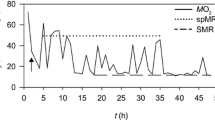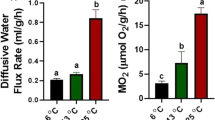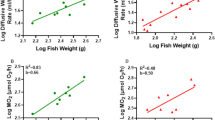Abstract
The Pacific hagfish (Eptatretus stoutii) is a representative of the most basal extant craniates, and is a marine osmoconformer with an extremely low metabolic rate (MO2 = 475 µmol O2/kg/h at 12 °C). We investigated potential physiological trade-offs associated with compensatory changes in gill ventilation and perfusion when 12 °C-acclimated hagfish were acutely exposed to 7 °C or 17 °C, as reflected in diffusive unidirectional water flux (\({J_{{{\text{H}}_2}{\text{O}}}}\), measured with tritiated water: 3H2O), net ammonia flux (Jamm), and plasma ion and acid–base status. \({J_{{{\text{H}}_2}{\text{O}}}}\) was high (~ 1.4 L/kg/h at 12 °C) in comparison to marine teleosts and elasmobranchs. MO2 increased linearly with temperature (R2 = 0.991), and was more sensitive (Q10 = 3.22) in the 12–7 °C range than either Jamm (1.86) or \({J_{{{\text{H}}_2}{\text{O}}}}\) (1.35), but the pattern reversed from 12 to 17 °C (Q10s: MO2 = 2.77, Jamm = 2.88, \({J_{{{\text{H}}_2}{\text{O}}}}\) = 4.01). Heart rate, ventilatory index (a proxy for total ventilation), and coughing frequency also increased but with different patterns. At 17 °C, plasma [Ca2+] and [Mg2+] decreased, although osmolality increased, associated with elevations in plasma [Na+] and [Cl−]. Blood pH and PCO2 were unaffected by acute temperature changes while [HCO3−] increased. Hyperoxia (PO2 > 300 Torr) attenuated the increase in \({J_{{{\text{H}}_2}{\text{O}}}}\) at 17 °C, did not affect Jamm, and had diverse effects on plasma ion and acid–base status. Our results suggest a clear osmorespiratory compromise occurring for the diffusive water fluxes as a result of acute temperature changes in this osmoconformer.










Similar content being viewed by others
References
Adam H, Strahan R (1963) Notes on the habitat, aquarium maintenance and experimental use of hagfish. In: Brodal A, Fange R (eds) The biology of Myxine. Scandinavian University Books, Oslo, pp 33–41
Baker DW, Sardella B, Rummer JL, Sackville M, Brauner CJ (2015) Hagfish: champions of CO2 tolerance question the origins of vertebrate gill function. Sci Rep 5:11182
Barss WH (1993) Pacific hagfish, Eptatretus stoutii, and black hagfish, E. deani: the Oregon fishery and port sampling observations, 1988–92. Mar Fish Rev 55(4):19–30
Bellamy D, Chester Jones I (1961) Studies on Myxine glutinosa—I. The chemical composition of the tissues. Comp Biochem Physiol 3:173–183
Boutilier RG, Heming TA, Iwama JK (1984) Appendix: physicochemical parameters for use in fish respiratory physiology. In: Hoar WS, Randall DJ (eds) Fish physiology: gills, vol 10. Academic Press, Orlando, pp 403–430
Braun MH, Perry SF (2010) Ammonia and urea excretion in the Pacific hagfish Eptatretus stoutii: Evidence for the involvement of Rh and UT proteins. Comp Biochem Physiol (A) 157:405–415
Butler PJ, Taylor EW (1975) The effect of progressive hypoxia on respiration in the dogfish (Scyliorhinus canicula) at different seasonal temperatures. J Exp Biol 63:117–130
Cameron J, Heisler N (1983) Studies of ammonia in the rainbow trout: physicochemical parameters, acid-base behaviour and respiratory clearance. J Exp Biol 105:107–125
Carrier JC, Evans DH (1972) Ion, water and urea turnover rates in the nurse shark, Ginglymostoma cirratum. Comp Biochem Physiol (A) 41:761–764
Cholette C, Gagnon A, Germain P (1970) Isosmotic adaptation in Myxine glutinosa L.—I.—Variations of some parameters and role of the amino acid pool of the muscle cells. Comp Biochem Physiol 33:333–346
Clark TD, Jeffries KM, Hinch SG, Farrell AP (2011) Exceptional aerobic scope and cardiovascular performance of pink salmon (Oncorhynchus gorbuscha) may underlie resilience in a warming climate. J Exp Biol 214:3074–3081
Clarke AJN, Johnston NM (1999) Scaling of metabolic rate with body mass and temperature in teleost fish. J Anim Ecol 68:893–905
Clifford AM, Guffey SC, Goss GG (2014) Extrabranchial mechanisms of systemic pH recovery in hagfish (Eptatretus stoutii). Comp Biochem Physiol (A) 168:82–89
Clifford AM, Goss GG, Wilkie MP (2015) Adaptations for a deep sea scavenger: extreme ammonia tolerance and active NH4 + excretion by the Pacific hagfish (Eptatretus stoutii). Comp Biochem Physiol (A) 182:64–74
Clifford AM, Zimmer AM, Wood CM, Goss GG (2016) It’s all in the gills: evaluation of O2 uptake in the Pacific hagfish refutes a major respiratory role for the skin. J Exp Biol 219:2814–2818
Clifford AM, Weinrauch AM, Edwards SL, Wilkie MP, Goss GG (2017) Flexible ammonia handling strategies using both cutaneous and branchial epithelia in the highly ammonia-tolerant Pacific hagfish. Am J Physiol Regul Integr Comp Physiol 313(2):R78–R90
Clifford AM, Weinrauch AM, Goss GG (2018) Dropping the base: recovery from extreme hypercarbia in the CO2 tolerant Pacific hagfish (Eptatretus stoutii). J Comp Phys B 188(3):421–435
Cox GK, Sandblom E, Farrell AP (2010) Cardiac responses to anoxia in the Pacific hagfish, Eptatretus stoutii. J Exp Biol 213:3692–3698
Coxon SE, Davison W (2011) Structure and function of the velar muscle in the New Zealand hagfish Eptatretus cirrhatus: response to temperature change and hypoxia. J Fish Biol 79:280–289
Currie S, Edwards SL (2010) The curious case of the chemical composition of hagfish tissues—50 years on. Comp Biochem Physiol (A) 157:111–115
Edwards SL, Arnold J, Blair SD, Pray M, Bradley R, Erikson O, Walsh PJ (2015) Ammonia excretion in the Atlantic hagfish (Myxine glutinosa) and responses of an Rhc glycoprotein. Am J Physiol Regul Integr Comp Physiol 308:R769–R778
Eom J, Wood CM (2018) The ventilation mechanism of the Pacific hagfish, Eptatretus stoutii (Lockington 1878). J Fish Biol (in revision)
Evans DH (1967) Sodium, chloride, and water balance of the intertidal teleost, Xiphister atropurpureus. III. The roles of simple diffusion, exchange diffusion, osmosis and active transport. J Exp Biol 47:525–534
Evans DH (1969) Studies on the permeability to water of selected marine, freshwater and euryhaline teleosts. J Exp Biol 50:689–703
Evans DH (1984) Gill Na+/H+ and Cl–/HCO3 – exchange systems evolved before the vertebrates entered fresh water. J Exp Biol 113:465–469
Giacomin M, Schulte PM, Wood CM (2017) Differential effects of temperature on oxygen consumption and branchial fluxes of urea, ammonia, and water in the dogfish shark (Squalus acanthias suckleyi). Physiol Biochem Zool 90:627–637
Glover CN, Wood CM, Goss GG (2017) Drinking and water permeability in the Pacific hagfish Eptatretus stoutii. J Comp Physiol B 187(8):1127–1135
Gonzalez RJ (2011) The osmorespiratory compromise. In: Farell AP (ed) The encyclopedia of fish physiology: from genome to environment. Academic Press, Cambridge, pp 1389–1394
Grant SM (2006) An exploratory fishing survey and biological resource assessment of Atlantic hagfish (Myxine glutinosa) occurring on the southwest slope of the Newfoundland Grand Bank. J Northwest Atl Fish Sci 36:91–110
Hastey JP (2011) Effects of acute salinity and temperature change on Pacific hagfish, Eptatretus stoutii; Implications for by-catch post release survival. M.Sc. dissertation, The University of British Columbia
Heisler N (1984) Acid-base regulation in fishes. In: Hoar WS, Randall DJ (eds) Fish physiology: gills, vol 10. Academic Press, Orlando, pp 315–401
Heisler N (1993) Acid-base regulation in response to changes of the environment: characteristics and capacity. In: Rankin JC, Jensen FB (eds) Fish ecophysiology. Chapman & Hall, London, pp 207–226
Heisler N, Toews DP, Holeton GF (1988) Regulation of ventilation and acid-base status in the elasmobranch (Scyliorhinus stellaris) during hyperoxia-induced hypercapnia. Respir Physiol 71:227–246
Herr JE, Clifford AM, Goss GG, Fudge DS (2014) Defensive slime formation in Pacific hagfish requires Ca2+- and aquaporin-mediated swelling of released mucin vesicles. J Exp Biol 217:2288–2296
Lauff RF, Wood CM (1996) Respiratory gas exchange, nitrogenous waste excretion, and fuel usage during starvation in juvenile rainbow trout, Oncorhynchus mykiss. J Comp Physiol B 165:542–551
Lea JMD, Keen AN, Nudds RL, Shiels HA (2016) Kinematics and energetics of swimming performance during acute warming in brown trout Salmo trutta. 88: 403–417
Madsen SS, Engelund MB, Cutler CP (2015) Water transport and functional dynamics of aquaporins in osmoregulatory organs of fishes. Biol Bull 229:70–92
Malte H, Lomholt JP (1998) Ventilation and gas-exchange. In: Jorgensen JM, Lomholt JP, Weber RE, Malte H (eds) The biology of hagfishes. Chapman & Hall, London, pp 223–234
Martini FH (1998) The ecology of hagfishes. The biology of hagfishes. Chapman & Hall, London, pp 57–77
McInerney JE, Evans DO (1970) Habitat characteristics of the Pacific hagfish, Polistotrema stouti. J Fish Res Board Can 27(5):966–968
Moller PR, Jones JW (2007) Eptatretus strickrotti n. sp. (Myxinidae): first hagfish captured from a hydrothermal vent. Biol Bull 212:55–66
Motais R, Isaia J, Rankin JC, Maetz J (1969) Adaptive changes of the water permeability of the teleostean gill epithelium in relation to external salinity. J Exp Biol 51:529–546
Munz FW, Morris RW (1965) Metabolic rate of the hagfish, Eptatretus stoutii (Lockington) 1878. Comp Biochem Physiol A 16:1–6
Nilsson S (1986) Control of gill blood flow. In: Nilsson S, Holmgren S (eds) Fish physiology: recent advances. Croom Helm, London, pp 87–101
Nishimoto G, Sasaki G, Yaoita E, Nameta M, Li H, Furuse K, Fujinaka H, Yoshida Y, Mitsudome A, Yamamoto T (2007) Molecular characterization of water-selective AQP (EbAQP4) in hagfish: insights in ancestral origin of AQP4. Am J Physiol Regul Integr Comp Physiol 292:R644–R651
Olla BL, Davis MW, Schreck CB (1998) Temperature magnified post capture mortality in adult sablefish after simulated trawling. J Fish Biol 53:743–760
Onukwufor JO, Wood CM (2018) The osmorespiratory compromise in rainbow trout (Oncorhynchus mykiss): the effects of fish size, hypoxia, temperature and strenuous exercise on gill diffusive water fluxes and sodium net loss rates. Comp Biochem Physiol (A) 219–220: 10–18
Perry SF, Vulesevic B, Braun M, Gilmour KM (2009) Ventilation in Pacific hagfish, (Eptatretus stoutii) during exposure to acute hypoxia and hypercapnia. Resp Physiol Neurobiol 167:227–234
Rahn H, Baumgardner FW (1972) Temperature and acid-base regulation in fish. Resp Physiol 14(1–2):171–182
Randall DJ, Baumgarten D, Malyusz M (1972) The relationship between gas and ion transfer across the gills of fishes. Comp Biochem Physiol (A) 41:629–637
Reeves RB (1977) The interaction of body temperature and acid-base balance in ectothermic vertebrates. Ann Rev Physiol 39:559–586
Robertson JD (1976) Chemical composition of the body fluids and muscle of the hagfish Myxine glutinosa and the rabbit-fish Chimaera monstrosa. J Zool Lond 178:261–277
Rudy PP, Wagner RC (1970) Water permeability in the Pacific hagfish Polistostrema stouti and the staghorn sculpin Leptocottus armatus. Comp Biochem Physiol 34:399–403
Sardella BA, Baker DW, Brauner CJ (2009) The effects of variable water salinity and ionic composition on the plasma status of the Pacific hagfish (Eptatretus stoutii). J Comp Physiol B 179:721–728
Steffensen JF, Johansen K, Sindberg CD, Sørensen JH, Møller JL (1984) Ventilation and oxygen consumption in the hagfish, Myxine glutinosa L. J Exp Mar Biol Ecol 84:173–178
Verdouw H, Van Echteld CJA, Dekkers EMJ (1978) Ammonia determination based on indophenols formation with sodium salicylate. Water Res 12:399–402
Walsh PJ, Wang Y, Campbell CE, De Boeck G, Wood CM (2001) Patterns of nitrogenous waste excretion and gill urea transporter mRNA expression in several species of marine fish. Mar Biol 139:839–844
Wilkie MP, Clifford AL, Edwards SL, Goss GG (2017) Wide scope for ammonia and urea excretion in foraging Pacific hagfish. Mar Biol 164:126
Wood CM (1991) Branchial ion and acid-base transfer in freshwater teleost fish: environmental hyperoxia as a probe. Physiol Zool 64(1):68–102
Wood CM (2001) Influence of feeding, exercise, and temperature on nitrogen metabolism and excretion. In: Wright P, Anderson P (eds) Fish physiology: nitrogen excretion, vol 20. Academic Press, San Diego, pp 201–238
Worthington J (1905) Contribution to our knowledge of the Myxinoids. Am Nat 39(465):625–663
Wright PA (2007) Ionic, osmotic and nitrogenous waste regulation. In: Farrell AP, Brauner CJ (eds) Fish physiology: primitive fishes, vol 26. Academic Press, Orlando, pp 283–318
Wright PA, Wood CM (2016) Regulation of ions, acid-base, and nitrogenous wastes in elasmobranchs. In: Shadwick RE, Farrell AP, Brauner CJ (eds) Fish physiology: physiology of elasmobranch fishes: internal processes, vol 34B. Academic Press, San Diego, pp 279–345
Acknowledgements
This study was supported by Natural Sciences and Engineering Research Council of Canada (NSERC) Discovery Grants to CMW and PMS. MG is supported by a 4-year graduate fellowship from the University of British Columbia. We would like to thank Dr. Eric Clelland (Bamfield Marine Sciences Centre research coordinator) for excellent logistic support, Dr. Alex Clifford for providing helpful advice with calculations, and three anonymous reviewers whose comments and suggestions have greatly improved the manuscript.
Author information
Authors and Affiliations
Corresponding author
Additional information
Communicated by G. Heldmaier.
Rights and permissions
About this article
Cite this article
Giacomin, M., Eom, J., Schulte, P.M. et al. Acute temperature effects on metabolic rate, ventilation, diffusive water exchange, osmoregulation, and acid–base status in the Pacific hagfish (Eptatretus stoutii). J Comp Physiol B 189, 17–35 (2019). https://doi.org/10.1007/s00360-018-1191-0
Received:
Revised:
Accepted:
Published:
Issue Date:
DOI: https://doi.org/10.1007/s00360-018-1191-0




